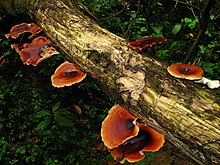Polyporus badius
| Royoporus badius | |
|---|---|
 |
|
| Specimens showing light coloring (above) and darker pigmentation (below) a few days later | |
 |
|
| Scientific classification | |
| Kingdom: | Fungi |
| Division: | Basidiomycota |
| Class: | Agaricomycetes |
| Order: | Polyporales |
| Family: | Polyporaceae |
| Genus: | Royoporus |
| Species: | R. badius |
| Binomial name | |
|
Royoporus badius (Pers.) De (1997) |
|
| Synonyms | |
|
|
Royoporus badius or Picipes badius, commonly known as the black-footed polypore or black-leg, is a species of fungus in the family Polyporaceae. It causes a white rot of hardwoods and conifers. The species is found in temperate areas of Asia, Australia, Europe, and North America. It has a dark brown or reddish-brown cap that reaches a diameter of 25 cm (9.8 in), and a stipe that is often completely black or brown at the top and black at the base.
The species was first described in the scientific literature in 1801 by Christian Hendrik Persoon, who named it Boletus badius. American mycologist Lewis David de Schweinitz transferred the species to Polyporus in 1832, and it was known by this name until 1997, when De transferred the species into the genus Royoporus, which he had described the year before. Polyporaceae species that are closely phylogenetically related to R. badius include P. dictyopus, P. melanopus, and P. tubaeformis, which have clamp connections on generative hyphae and a similar ecology. Zmitrovich & Kovalenko proposed the new genus Picipes for this fungus together with P. melanopus and P. tubaeformis and according to Species Fungorum Picipes badius is now the correct current name.
The specific epithet badius derives from the Latin root badi-, meaning "reddish brown". The common names "black-footed polypore" and "black-leg" refer to its characteristic dark-colored stipe.
...
Wikipedia
